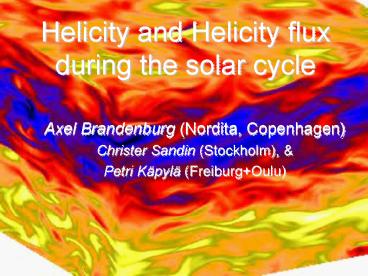Helicity and Helicity flux during the solar cycle - PowerPoint PPT Presentation
1 / 27
Title:
Helicity and Helicity flux during the solar cycle
Description:
Helical MHD turbulence. Helically forced turbulence (cyclonic events) ... Helical versus nonhelical and scale separation. Inverse cascade only when scale separation ... – PowerPoint PPT presentation
Number of Views:43
Avg rating:3.0/5.0
Title: Helicity and Helicity flux during the solar cycle
1
Helicity and Helicity flux during the solar cycle
- Axel Brandenburg (Nordita, Copenhagen)
- Christer Sandin (Stockholm),
- Petri Käpylä (FreiburgOulu)
2
Thirty years of turbulent diffusion
LS magnetic energy ?SS magnetic energy ?
dissipation
3
Worry magnetic energy peaked at small scales??
Maron Cowley (2001)
Meneguzzi et al (1981)
Kida et al (1991)
Conclusion until recently magnetic energy
peaked at the resistive scale!
Schekochihin et al (2003)
4
Nonhelically forced turbulence
Haugen, Brandenburg, Dobler (2003, ApJL)
Kazantsev spectrum confirmed (even for n/h1)
Spectrum remains highly time-dependent
5
256 processor run at 10243
-3/2 slope?
Haugen et al. (2003, ApJ 597, L141)
Result not peaked at resistive scale ? Kolmogov
scaling!
instead kpeakRm,crit1/2 kf 6kf
6
Thirty years of nonlinear dynamos
3-D helical turbulence with shear
Brandenburg, Bigazzi, Subramanian (2001)
7
However, a quenching could be in trouble!
catastrophic a quenching Rm dependent
(Vainshtein Cattaneo
1972, Gruzinov Diamond 1994-96)
conventional a quenching e.g., aB-3,
independent of Rm (Moffatt 1972, Rüdiger 1973)
periodic box simulations saturation at
super-equipartition, but after resistive
time (Brandenburg 2001)
open domains removal of magnetic waste by
helicity flux (Blackman Field 2000, Kleeorin et
al 2000-2003)
Dynamical quenching
Kleeorin Ruzmaikin (1982)
8
Cartesian box MHD equations
Magn. Vector potential
Induction Equation
Momentum and Continuity eqns
Viscous force
forcing function
(eigenfunction of curl)
9
Helical MHD turbulence
- Helically forced turbulence (cyclonic events)
- Small large scale field grows exponentially
- Past saturation slow evolution
- ? Explained by magnetic helicity equation
10
Allowing for scale separation
Position of the peak compatible with
No inverse cascade in kinematic regime
Decomposition in terms of Chandrasekhar-Kendall-Wa
leffe functions
11
Helical versus nonhelical and scale separation
Kida et al. (1991) helical forcing, but no
inverse cascade
Inverse cascade only when scale separation
12
Slow saturation
Brandenburg (2001, ApJ)
13
Connection with a effect writhe with internal
twist as by-product
clockwise tilt (right handed)
W
? left handed internal twist
Yousef Brandenburg AA 407, 7 (2003)
both for thermal/magnetic buoyancy
14
MTA the Minimal Tau Approximation
- 1st aspect replace triple correlation by
quadradatic - 2nd aspect do not neglect triple correlation
- 3rd aspect calculate
- rather than
Similar in spirit to tau approx in EDQNM ?
(Kleeorin, Mond, Rogachevskii 1996, Blackman
Field 2002, Rädler, Kleeorin,
Rogachevskii 2003)
15
Implications of MTA
- MTA does not a priori break down at large Rm.
- (Strong fluctuations of b are possible!)
- Extra time derivative of emf
- ? hyperbolic eqn, oscillatory behavior possible!
- t is not correlation time, but relaxation time
with
16
Revised nonlinear dynamo theory(originally due
to Kleeorin Ruzmaikin 1982)
Two-scale assumption
Production of large scale helicity comes at the
price of producing also small scale magnetic
helicity
17
Express in terms of a
? Dynamical a-quenching (Kleeorin Ruzmaikin
1982)
Also Schmalz Stix (1991)
no additional free parameters
Steady limit consistent with Vainshtein
Cattaneo (1992)
(algebraic quenching)
Is ht quenched? ? can be checked in models with
shear
18
Full time evolution
(ht quenched constant)
Significant field already after kinematic growth
phase
followed by slow resistive adjustment
19
Is ht quenched?can be in models with shear
Larger mean field
Slow growth but short cycles Depends
on assumption about ht-quenching!
20
Additional effect of shear
Negative shear
Positive shear
Consistent with g3 and
Kitchatinov et al (1996), Kleeorin Rogachevskii
(1999) Blackman Brandenburg (2002)
21
Current helicity flux
- Advantage over magnetic helicity
- ltj.bgt is what enters a effect
- Can define helicity density
Rm also in the numerator
22
Large scale vs small scale losses
Diffusive large scale losses ? lower saturation
level (Brandenburg Dobler 2001)
Periodic box
with LS losses
Small scale losses (artificial) ? higher
saturation level ? still slow time scale
Numerical experiment remove field for kgt4 every
1-3 turnover times (Brandenburg et al. 2002)
23
Significance of shear
- a ? transport of helicity in k-space
- Shear ? transport of helicity in x-space
- Mediating helicity escape (? plasmoids)
- Mediating turbulent helicity flux
Expression for current helicity flux
(first order smoothing, tau approximation)
Schnack et al.
Vishniac Cho (2001, ApJ)
Expected to be finite on when there is shear
Arlt Brandenburg (2001, AA)
24
Simulating solar-like differential rotation
- Still helically forced turbulence
- Shear driven by a friction term
- Normal field boundary condition
25
Helicity fluxes at large and small scales
Negative current helicity net production in
northern hemisphere
1046 Mx2/cycle
26
Impose toroidal field ? measure a
previously
27
Where do we stand after 30 years
- Mean-field theory qualitatively confirmed!
- Convection (e.g. Ossendrijver), forced turbulence
- Alternatives (e.g. WxJ and SJ effects) to be
explored - Homogeneous dynamos saturate resistively
- Entirely magnetic helicity controlled
- Inhomogeneous dynamo
- Open surface, equator
- Current helicity flux important
- Finite if there is shear
- Avoid magnetic helicity, use current helicity































